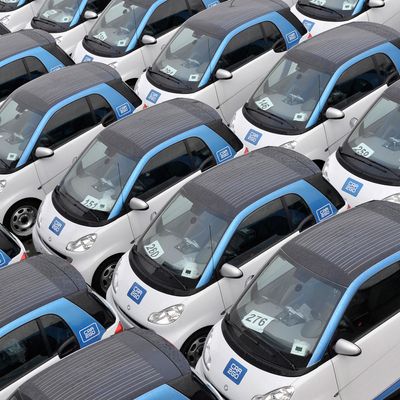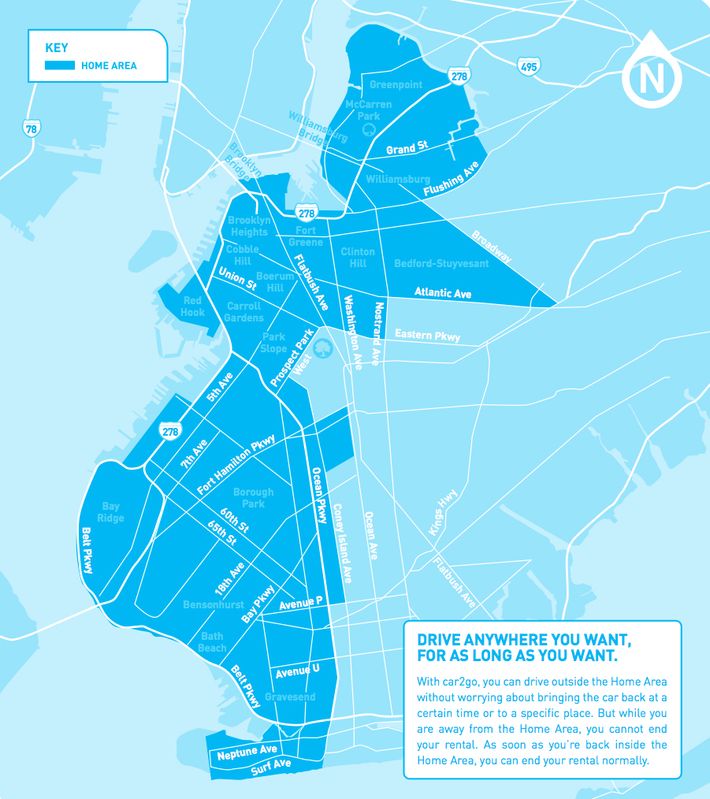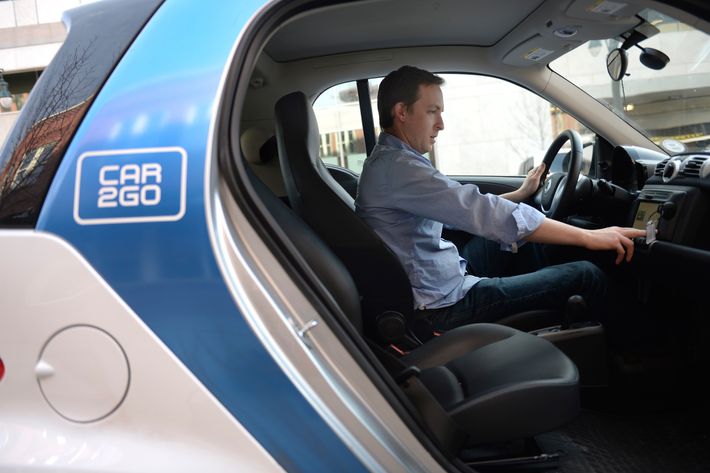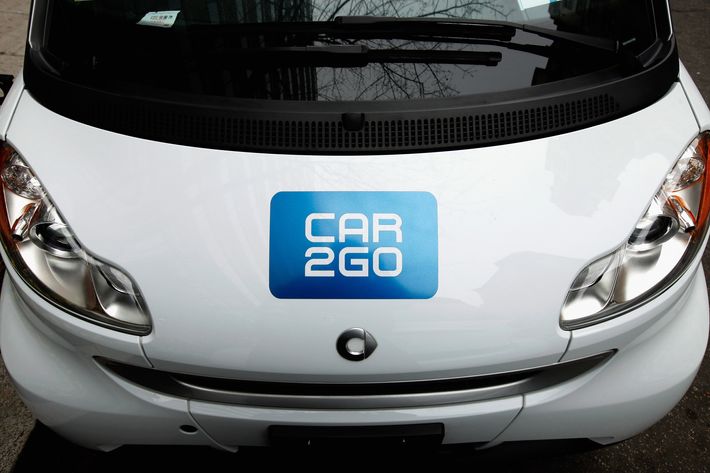
Like many Brooklynites, 55-year-old Anthony Alfano was baffled by the tiny blue-and-white Smart cars that have invaded his borough. On a brisk December afternoon, he sidled up to one in his native Cobble Hill, pointed toward its painted-on logo (simple, blocky letters reading “CAR2GO”), and yelled out, “You driven one of these?”
“Yes!” replied Thomas McNeil, Car2Go’s New York location manager. He was about to give me a ride-along demonstration of the vehicle in front of us but was more than happy to make time for a sales pitch. After all, in the city’s increasingly insane race between next-generation transportation companies, Car2Go is a late entry, only arriving here in October. Plus, it’s not immediately obvious what it has to offer New Yorkers: It’s a car-rental company, and this is a city where practically everyone takes cabs, buses, and trains.
So McNeil can’t afford to lose a single potential customer. “You should try it!” he told Alfano, then eased into the basic Car2Go pitch: Unlike traditional rentals, you pay for a Car2Go Smart car by the minute (41 cents a minute, plus tax); the cars are distributed throughout a 36-square-mile “home area” in western Brooklyn, from Williamsburg down to Bay Ridge; and you make the rentals with a smartphone app. “That ain’t too bad!” Alfano said, nodding.
Then McNeil went in for the kill: “But the best part about it? You’d be able to get this car right here on your smartphone, get in the car, go to any neighborhood you wanted in our home area, park the car there legally, and just leave it! You don’t have to return it back to this spot!”
“That’s terrific!” Alfano said, beaming. He struggled to think of a specific use for that kind of rental, but seemed eager to come up with one. Like thousands of his fellow Brooklynites, he was immediately enthusiastic about Car2Go — or, at least, the idea of it. Just a few months after its 400-car fleet rolled out of a warehouse in Red Hook, the company is making a strong impression across the borough. But with resistance from City Hall, byzantine traffic laws, and the fact that New Yorkers aren’t all that big on driving themselves anywhere, will that be enough to start making, well, money?
Car2Go’s phraseology for its service can be a little vague (terms like “free floating,” “one-way car-share,” and “point-to-point” pop up frequently), so perhaps some comparisons will help describe it. Car2Go is like Zipcar, in that it’s a car-rental service with vehicles scattered in street parking spots. It’s like Citi Bike, in that you generally use it for short trips and don’t have to return it to the same place you picked it up (even Zipcar forces you to make a round trip back to the lot). And it’s like Uber, in that you find your ride by whipping out your smartphone and looking to see if there are cars nearby.
That means you can get wheels for a quick grocery run. Or you can head to an event and not worry about running down the clock on your rental, because you can simply park the car and you’re done. Or you can cruise to a bar, drink freely, then not have to worry about getting behind the wheel again. Just don’t break the rules — if you end a trip by parking outside the home area or in a no-parking zone, you’ll most likely have to pay the parking ticket; if you drive more than 150 miles outside the home area, the company can remotely lock you out of the car as soon as you exit it.
The formula has already caught on around the planet. German automotive behemoth Daimler AG owns Car2Go, launching it in the small German city of Ulm in 2008. Two years later, the company expanded to Austin, Texas. From 2011 to 2014, it rolled out in dozens more cities across Western Europe, Canada, and the U.S. Car2Go is now a part of daily commuter life for people in 29 cities, from Berlin (where they have their biggest fleet, 1,200 cars strong) to Vancouver. There have been failures, most notably in the U.K., where programs in London and Birmingham were shut down last spring for unspecified reasons. But for the most part, Car2Go has built an empire without resistance.
However, New York’s transportation situation is quite different from the other cities in that empire — and those differences make the city a special challenge for Car2Go. For one thing, we have the lowest rate of car ownership of any American city (as of 2012, a whopping 56.5 percent of New York City households were carless, compared to 9.2 percent nationally). While that fact offers some opportunity, the lack of a local driving culture also presents a big problem: One of Car2Go’s main selling points is that it’s a cheap replacement for owning a car, but if you don’t own a car to begin with, would you be inclined to add one to your transportation diet? “Really, our focus is people that own cars already, that might reconsider owning a car here in Brooklyn,” McNeil said. “We’re not looking to put people in cars that aren’t in cars.”

And if you do drive a car in New York, you’re all too familiar with the city’s infamously difficult parking situation. Indeed, parking questions derailed Car2Go’s initial vision for its New York operation last year, before the cars even hit the streets. The battle lines were drawn over parking meters. In many cities, the company has struck a deal with the local government to allow Car2Go users to park the Smart cars at metered spots for free (in exchange, the company pays the city to make up for lost meter revenue). Car2Go asked New York’s Department of Transportation for such a deal, but the DOT refused. As it stands, you can park at a metered spot during your rental, but you have to feed the meter and you can’t leave the car there when you finish the rental — you have to put it in on-street parking.
Relations between Car2Go and DOT have been chilly ever since. McNeil said the company is “still in talks” to get free access to metered spots, but the DOT wouldn’t comment on whether such talks were actually happening. Indeed, all the agency would say about Car2Go was this cryptic, two-line statement: “NYC DOT is open to more transportation options that make New Yorkers more mobile around their city. Car2Go is in its preliminary months and we look forward to seeing more data about how the program has worked in Brooklyn thus far.” It appears that the city has adopted a trust-but-verify approach to this new kid in town.
Despite all of these challenges and speed bumps, Car2Go has gained some traction since its October launch. They say they have 20,000 members here, many of them recruited through in-person outreach at events throughout Brooklyn.
Early adopters say they have no trouble finding uses for by-the-minute car rentals. Sunset Park resident Ian Westcott will hop in a Car2Go to see his girlfriend (her Ridgewood apartment is ever-so-slightly outside the home area, so he’ll park his Car2Go in East Williamsburg and walk the rest of the way). “On buses or trains, we’re an hour away from each other,” he told me. “On Uber and taxis, when the weather isn’t nice enough to bike, that can run to $35 or $40 a ride. With Car2Go, it’s $15 for the ride.” Amelia Lester, who lives in Williamsburg, uses the service to drive to dinner with friends in Bedford-Stuyvesant or Park Slope. “I think it’s incredible for city driving,” she says. “And you can squeeze that little nugget car into any space!”

The users I talked to all had their complaints, of course. They spoke of a day a few weeks ago when the company’s servers went down and you couldn’t rent anything for a few hours. They griped about how scary it can be to drive a Smart car on Brooklyn’s heavily potholed roads. “The suspensions kinda suck,” Westcott said. “There were situations where I thought I was gonna die.”
And they also say you can’t always find a car when you need one — this in spite of the efforts of Car2Go’s “street team” to distribute vehicles evenly through the coverage zone. The 40-person squad patrols the borough for vehicles that are out of gas, illegally parked, too densely packed in one region, or otherwise causing problems. One street-team soldier told me the biggest single problem was, unsurprisingly, cars improperly parked in alternate-side parking areas — though he hastened to add that there are very few problems for the fleet on any given day.
If none of these problems spin out of control, Car2Go plans to expand — though the company seems to lack Uber’s appetite for world domination. McNeil told me they have no interest in Manhattan and are going to stick to the outer boroughs, where subway service is spottier and there are more existing drivers who stand to save money by renting instead of owning. Car2Go, in other words, wants to fit into the city, not remake it. “New York uses public transportation,” he said. “We help assist with that.” But it seems likely that some users will be adding driving to their lives, rather than merely replacing their mode of driving. That could, of course, someday lead to a net rise in the number of people using cars here, and that would mean congestion. But right now, the fleet is so small — and the cars, themselves, are so small — that any such problem is very a distant possibility. It might even be one that the company would look forward to having.






























